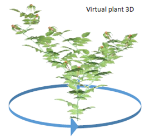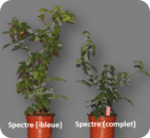- Index
- >Innovation
- >The innovation box
- >7. Produce better your ornamental plants
- >Research results
Contents
- Measurement of visual quality at the service of plant breeding
- Control of branching through innovative ways
- Towards healthier ornamental plants!
- Recurrent blooming, a controllable trait at last!
- The fragrance of the rose at hand
- Towards roses without thorns
|
|
|
|
|
|
|
The researchers of the IRHS (Research Institute in Horticulture and Seeds) study the physiological and molecular mechanisms associated with these morphological or physiological characteristics. This knowledge is essential for the improvement of breeding programs and the development of innovative cropping systems. The IRHS works in collaboration with the GRAPPE (ESA-INRA) unit to better integrate consumer’s expectations into the innovation processes of professionals.
Measurement of visual quality at the service of plant breeding
The shape of the plant is an important ornamental criterion which determines its commercial value.

The CIFRE thesis carried out by the DESMARTIS nurseries in collaboration with the research units IRHS and GRAPPE made it possible to develop a method for objective measurement of the visual quality of a rose bush.
→ This method is transferable to other ornamental species and allows to consider visual quality in your breeding programs.

 Gilles Galopin
Gilles Galopin
gilles.galopin @ agrocampus-ouest.fr
Rachid Boumaza
rachid.boumaza@agrocampus-ouest.fr
Control of branching through innovative ways
The IRHS has elucidated genetic, physiological and molecular mechanisms underlying bud bursting and stem growth in response to various environmental factors:
|
|
Branching depends on both genotype and environment: water supply and quality of ligh. 'ARIAGE' CASDAR project + CIFRE thesis - Camille Li-Marchetti, realized in collaboration with ASTREDHOR
laurent.crespel @ agrocampus-ouest.fr Philippe Morel-Chevillet philippe.morel-chevillet @ inra.fr
|
|
|
The elongation of the roses can be controlled by the quality of the luminous spectrum.
nathalie.leduc @ univ-angers.fr Lydie Thelier |
|
|
Within the framework of their theses, Adrien Corot (2015-2017) and Anne Schneider (2016-2018) analyze the effect of plant hormones (auxines, SLs ...) and sugars on the control of branching in response to the intensity of light.
sabine.demotes-ainard @ inra.fr Jessica Bertheloot |
|
|
In her thesis, Marie-Anne Le Moigne (2014-2017) investigates the involvement of amino acids in the nutrition of the axes growing in the rose bush.
|
Interests for the professionals :
- Improve technical itineraries by modulating environmental factors, to:
- Set up or maintain a plant shape
- Free from growth regulators
- Produce organs or metabolites of interest
- Select varieties for their architecture
Towards healthier ornamental plants!
 The rosierists of Doué la Fontaine have teamed up with the IRHS researchers to understand the origins of graft falls. Several hypotheses have been studied (genetics, incompatibility with the rootstock, grafting technique, soil and climate conditions...). The results indicated that the climatic factors and the quality of the graft could explain in part this phenomenon (Regional Innovation Platform project on the rose bush, 2012-2016).
The rosierists of Doué la Fontaine have teamed up with the IRHS researchers to understand the origins of graft falls. Several hypotheses have been studied (genetics, incompatibility with the rootstock, grafting technique, soil and climate conditions...). The results indicated that the climatic factors and the quality of the graft could explain in part this phenomenon (Regional Innovation Platform project on the rose bush, 2012-2016).
|
|
Souliman Sakr soualiman.sakr@agrocampus- ouest.fr
|

In partnership with rosierists and the Végépolys R&D center , researchers of IRHS developed a routine greenhouse test to assess the resistance of rosebush varieties to black spot diseas.
BELAROSA project, 2013-2017
|
|
|
|
The thesis of Diana Lopez Suarez 2017-2020) aims to identify marker genes for rose bush resistance to black spot disease.
Vanessa Soufflet-Freslon |

As part of the PHYSI'HO collaborative project (2012-2017), the IRHS and hydrangea producers of Maine et Loire (Chauvin Hortensia, Hortensia France Production, SIcamus Productions) have identified physiological and molecular markers of resistance to a hydrangea disease.
|
|
|
Recurrent blooming, a controllable trait at last!


The molecular and physiological characterization of the recurrent flowering gene (Iwata et al., 2012, Randoux et al., 2013, 2014) opens interesting pathways for the control of flowering in the rose bush by the environment (Starter project INRA-BAP ) and by biotechnological means - GENIUS Investissements d’avenir project, 2012-2018.
The GENIUS project, in collaboration with the nurseries and rose gardens Georges Delbard , deals with cellular engineering. It aims at technological improvement and innovation for the plants of a sustainable agriculture.
 Fabrice Foucher
Fabrice Foucher
The fragrance of the rose at hand
 In collaboration with the team of Sylvie Baudino (BvPAM, University of Saint-Etienne), the researchers identified the gene RhNUDX1 as responsible for perfume in rose (published in Science); this gene is a potential marker of perfumed varieties of roses!
In collaboration with the team of Sylvie Baudino (BvPAM, University of Saint-Etienne), the researchers identified the gene RhNUDX1 as responsible for perfume in rose (published in Science); this gene is a potential marker of perfumed varieties of roses!

 Fabrice Foucher
Fabrice Foucher
Sylvie Baudino
sylvie.baudino@univ-st-etienne.fr
Towards roses without thorns
 In collaboration with the Flower Research Institute (Kunming, China), the IRHS studies and characterizes the genes involved in the appearance of thorns in the rose
In collaboration with the Flower Research Institute (Kunming, China), the IRHS studies and characterizes the genes involved in the appearance of thorns in the rose
Ningning Zhou Thesis, 2017-2020
 Fabrice Foucher
Fabrice Foucher
Contacts
Looking for partners?
Two contacts to support your projects:
- Aurore Gautier,
 contact to support your R&D projects land to put you through
contact to support your R&D projects land to put you through
aurore.gauthier @ vegepolys.eu
- Tanegmart Redjala,
 close interface with the laboratories of the Research Federative Structure Quasav.
close interface with the laboratories of the Research Federative Structure Quasav.






















